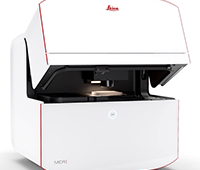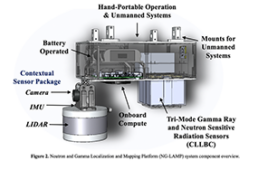Comparison of a SLIM and dSLIT image of an E. coli cell. It can be seen that dSLIT reveals a helical sub-cellular structure which was not resolvable just using SLIM. The diameter of the cell is approximately 0.5 microns. Image courtesy Mustafa Mir. |
A
sub-cellular world has been opened up for scientists to study E. coli
and other tissues in new ways, thanks to a microscopy method that
stealthily provides three-dimensional, high-quality images of the
internal structure of cells without disturbing the specimen.
By
combining a novel algorithm with a recently-developed add-on technique
for commercial microscopes, researchers at the University of Illinois
have created a fast, non-invasive 3D method for visualizing,
quantifying, and studying cells without the use of fluorescence or
contrast agents.
In a paper published online recently in the journal PLoS ONE, the researchers who developed the technique reported that they were able to use it to visualize the E. coli bacteria with a combination of speed, scale, and resolution unparalleled for a label-free method.
The
method is based on a broadband interferometric technique known as spatial light interference microscopy (SLIM) that was designed by
Beckman Institute researcher Gabriel Popescu
as an add-on module to a commercial phase contrast microscope. SLIM is
extremely fast and sensitive at multiple scales (from 200 nm and up)
but, as a linear optical system, its resolution is limited by
diffraction.
By
applying a novel deconvolution algorithm to retrieve sub-diffraction
limited resolution information from the fields measured by SLIM, Popescu
and his fellow researchers were able to render tomographic images with a
resolution beyond SLIM’s diffraction limits. They used the sparse
reconstruction method to render 3D reconstructed images of E. coli cells, enabling label-free visualization of the specimens at sub-cellular scales.
Last
year the researchers successfully demonstrated a new optical technique
that provides 3D measures of complex fields called Spatial Light
Interference Tomography (SLIT) on live neurons and photonic crystal
structures. In this project they developed a novel algorithm to further
extend the three-dimensional capabilities by performing deconvolution on
the measured 3D field, based on modeling the image using sparsity
principles. This microscopy capability, called dSLIT, was used to
visualize coiled sub-cellular structures in E. coli cells.
The
researchers said that these structures have only been observed using
specialized strains and plasmids and fluorescence techniques, and
usually on non-living cells. These new methods provide a practical way
for non-invasive study of such structures.
Mustafa Mir is first author on the paper and member of Popescu’s Quantitative Light Imaging Laboratory
at Beckman. Mir said that studying and understanding the
3D internal structure of living cells is essential for
furthering our understanding of biological function.
“Visualizing
them is extremely challenging due to their small size and transparent
nature,” Mir said. “This new method, however, provides a way to take
advantage of the intrinsic properties of these very small, transparent
cells non-invasively and without the use of fluorescence techniques and
contrast agents.
“Previous
studies have thus used extrinsic contrast such as fluorescence and
specialized strains in combination with complex superresolution
techniques for such studies. This will allow biologists to study
sub-cellular structures while minimally perturbing the cell from its
natural state.”
Fluorescence
microscopy is commonly used in cell biology for high contrast imaging
and labeling of cell structures; it also enables what are called
superresolution methods that have provided transverse resolution in the
20 to 30 nm scale, but the method comes with limitations due to
illumination intensity. Using confocal microscopy has added the element
of three-dimensional imaging but with this and other techniques, the
researchers point out in their paper, “only the amplitude (intensity) of
the field is measured in all these methods.
“Here
we show that if, instead of just measuring intensity, the complex field
(i.e., phase and amplitude) is measured, the 3D reconstruction of the
specimen structure can be obtained without the need for exogenous
contrast agents.”
Measuring the phase shift that the specimen adds to the optical field at each point in the field of view is known as quantitative phase imaging,
an imaging method for which Popescu developed the SLIM modality. It
provides extremely sensitive phase measurements of thin, transparent
structures such as the E. coli cells studied here.
The
researchers wrote that the method addresses two major issues in cell
microscopy: lack of contrast, due to the thin and optically transparent
nature of cells, and diffraction limited resolution. They write that
dSLIT’s ability to retrieve limited resolution information delivered by
SLIM will give researchers a tool to study structures like E. coli cells in a completely new way, thereby providing novel insights into cellular function.
“Although
several such structures have been previously identified, little is
known about their function and behavior due to the practical
difficulties involved in imaging them,” they concluded. “The results
presented here indicate that dSLIT can be used to characterize and study
such sub-cellular structure in a practical and non-invasive manner,
opening the door for a more in depth understanding of the biology.”
The paper is titled Visualizing Escherichia coli sub-cellular structure using sparse deconvolution spatial light interference tomography. Along with Mir and Popescu, authors include Beckman faculty member Minh Do and Beckman Postdoctoral Fellow S. Derin Babacan,
as well as faculty member Ido Golding and graduate student Michael
Bednarz from the Department of Physics. Popescu said the project was an
excellent example of how different disciplines can work together.
“I
believe this is a project that illustrates best the cross-pollination
between different areas of expertise, which is so well nurtured at the
Beckman Institute,” Popescu said. “We used a novel optical method in
combination with advanced computer algorithms to tackle a problem of
significance in biology.”
Source: University of Illinois





